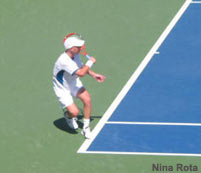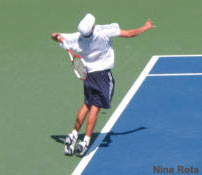I’m beginning to think that performance enhancing drugs (PED’s) should be a new category in sports columns and websites right after Nascar and just before rugby (is there a pro Quidditch league yet?).
Tennis is right there in the thick of PED culture. Argentine Guillermo Canas has just been suspended for two years after testing positive for the diuretic hydrochlorothiazide (HCT). He is the fourth Argentine to be supended for a drug violation. Juan Ignacio Chela, Guillermo Coria and Mariano Puerta all served suspension for banned PED’s.
Puerta was suspended the longest, nine months. That’s a long time but it’s nothing like two years. That’s a lifetime to a tennis player. Can you imagine if Rafael Palmeiro had received a two year suspension? End of career.
Canas received an automatic two year suspension because tennis adheres to the World Anti-Doping Agency’s guidelines, the same as those used in the Olympics.
If a two year suspension wasn’t bad enough, Canas also has to repay $276,070 in prize money and forfeit 525 singles and 95 doubles rankings points. How is this determined? Do they figure out how long the banned substance stayed in his body, calculate how much he won during that period then ask for the money back?

Mybe they should do that in baseball. Calculate how long the stanozolol stayed in Palmeiro’s body then go back and take away all of the hits he had during that period. By the way, you can see why the Major League Baseball union is fighting tooth and nail against being subject to the World Anti-Doping Agency’s policies.
Can you imagine if Rafael Palmeiro had received a two year suspension? End of career.
I am not convinced that steroids are bad for you. You can read more about that here. If it turns out that DHEA will extend my lifespan with few side effects and I find a doctor willing to give me a protocol for it, what right do I have to tell a ballplayer that he can’t use steroids under medical supervision? The bigger problem here is the decade or so of lies and the continuing lack of disclosure. The collective bargaining agreement between baseball and the players’ union has a confidentiality agreement. When a player tests positive, the test results are not released.
Tennis is smarter than baseball. As Harvey Araton pointed out in The New York Times this morning, if you go to the ATP website you can find all the information you want. Click on Press Room then Anti-Doping and you will see links to a list of banned substances and yearly testing reports. You can even print up your own anti-doping wallet card with a list of banned substances. There are at least nine categories and more than one hundred and twenty substances – including 18 _-homo-17ß-hydroxyestr-4-en-3-one and, yes, chlorothiazide.
If you click on Information, you get a list of every anti-doping decision, in English, Spanish and sometimes French, every player sanctioned and the substance they were sanctioned for. This is what we call full disclosure
A few years ago I read an article in the New Yorker about a military officer whose daughter died unexpectedly during a stay at a military hospital. The officer was convinced that medical personnel made a mistake and covered it up. He spent a number of years and all of his resources pursuing a legal decision in the matter. He was in the military, he knew that mistakes happen, but when you make one, the best way to diffuse the situtation is to fully disclose what happened.
No one has died here but if you want to make a situation much worse that it otherwise might be, screw up and then lie about it. Ask Richard Nixon and Bill Clinton about that.


